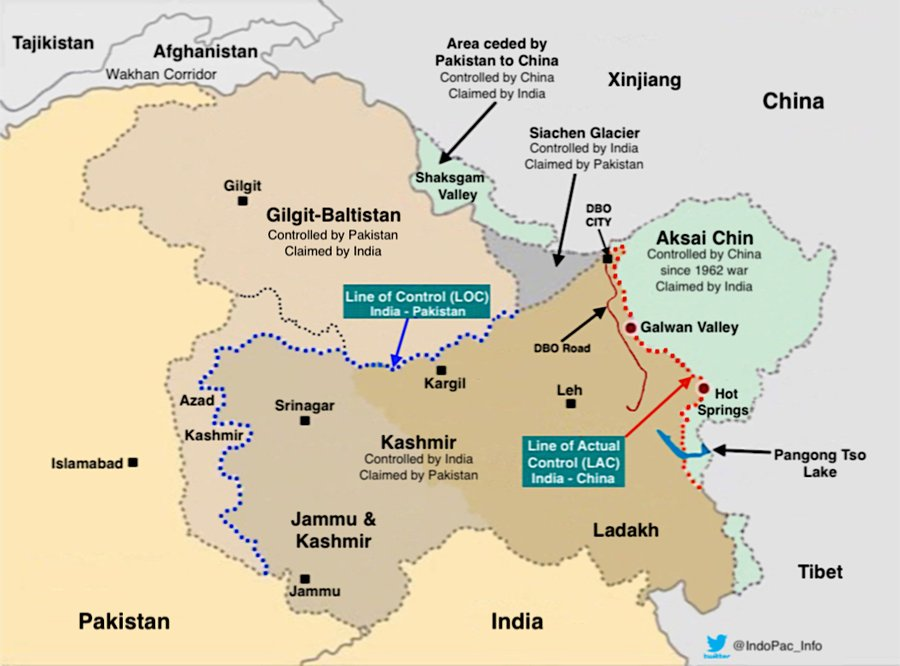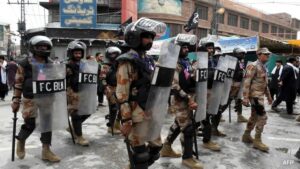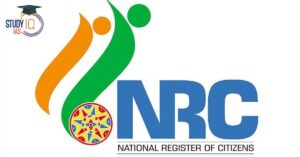Table of Contents
Shaksgam Valley
Context
- India has lodged a strong protest with China for carrying out construction activities in the Shaksgam valley, in an “illegal” attempt to alter the situation on the ground.
- Recent satellite images show China building a road reaching lower Shaksgam Valley, less than 50 km from the Siachen glacier held by India.
About Shaksgam Valley

- The Shaksgam Valley or the Trans Karakoram Tract is part of the Hunza-Gilgit region of Pakistan-Occupied Kashmir (POK).
- It borders Xinjiang Province of the People’s Republic of China (PRC) to the north, the Northern Areas of POK to the south and west, and the Siachen Glacier region to the east.
- The Shaksgam Tract, which includes the Shaksgam Valley, is an area of 5,200 sq km north of the Karakoram watershed that was earlier occupied by Pakistan in 1947.
- In 1963, the Shaksgam Valley was ceded to China by Pakistan.
Liquid Nitrogen
Context
- A recent viral video showed a child suffering after consuming food infused with liquid nitrogen.
- This sparked public concern and prompted the Tamil Nadu government to issue an advisory banning the use of liquid nitrogen in food and warned of stringent action against violators.
About Liquid Nitrogen
- Liquid nitrogen is inert, colourless, odourless, non-corrosive, and non-flammable.
- It qualifies as a cryogenic liquid, which means it remains liquefied at extremely low temperatures, specifically below –130°F (–90°C).
- The boiling point of liquid nitrogen is –320°F (–196°C).
- Health Risks:
- Contact with liquid nitrogen can cause severe cold burns resembling frostbite, affecting organs or body parts.
- Exposure can harm the lips, tongue, throat, lungs, and stomach, potentially causing burns or lesions on tissues.
- Ingestion can lead to stomach perforations, and inhalation into the lungs might produce CO2, possibly resulting in unconsciousness.
| Dragon’s Breath |
| Dragon’s breath is a type of cereal snack that is treated with liquid nitrogen. When consumed, it creates a vapour that looks like smoke, which can be exhaled through the nose and mouth. |
Usage of Liquid Nitrogen
- Food Production and Preparation: In 1991, a technique was developed to use liquid nitrogen droplets in food packaging to improve shelf life and quality.
- Liquid nitrogen displaces oxygen in the package, preventing microbial growth and preserving freshness.
- This method has been used for products like coffee, potato chips, peanuts, and dairy items.
- Some chefs have experimented with liquid nitrogen for its novelty factor to create visually appealing dishes.
- Scientific Uses of Liquid Nitrogen: Liquid nitrogen is a cryogenic fluid used in various medical applications since the 1960s.
- In surgical oncology, it freezes and destroys cancer cells at -196°C (cryotherapy).
- Other applications include obtaining biopsies and removing foreign bodies.
- Industrial Use: It includes cooling trays filled with liquid nitrogen for quick cooling of materials or equipment.
- Wellness and Sports: Liquid nitrogen vapour is utilised in cryosaunas for cryotherapy treatments.
- Technology and Materials Sciences: Liquid nitrogen is used to test chambers to evaluate the performance and durability of materials and devices under extremely low temperatures.
US Fed Rates and Impact on India
Context
- The U.S. Federal Reserve held interest rates steady ,maintaining the benchmark policy rate between 5.25% and 5.50%.
- The Fed signalled potential future reductions in borrowing costs but noted that recent disappointing inflation readings could delay these cuts.
More In News
- Inflation Rate: The personal consumption expenditures price index, which is the Fed’s preferred measure of inflation, showed an annual increase of 2.7% in March, marking an acceleration from the previous month.
- Economic Growth: The economy continued to expand at a solid pace, with strong job gains and a low unemployment rate.
- However, GDP growth in the first quarter was relatively weak at 1.6%, which Fed attributed to stronger private domestic demand (3.1%) as a more accurate reflection of economic conditions.
What are its Impacts?
Global Impact
- The delay in US rate cuts could dampen global economic growth, especially with China’s slowdown.
- Lower US interest rates could make emerging markets like India more attractive for foreign investment.
- This could lead to increased foreign investment in emerging market equities and currency inflows.
Implications for India
- Attractiveness for Currency Carry Trade: If the U.S. Federal Reserve decides to cut rates, the interest rate differential between the U.S. and India could widen.
- This would make India more attractive for the currency carry trade, where investors borrow money in a country with lower interest rates (like the U.S.) and invest it in a country with higher rates (like India) to profit from the difference.
- Impact on Foreign Investments: Lower interest rates in the U.S. might redirect some investment flows towards emerging markets like India, where returns on investments could be higher.
- This is particularly relevant for the bond market but can also affect equities.
- S. inflation rates reported by the Bureau of Labor Statistics showed a month-on-month increase of 0.4% and a year-on-year surge of 3.5%. Such inflation trends in the U.S. influence global market sentiments and can impact foreign investment flows into India.
- Influence on RBI’s Monetary Policy: The Reserve Bank of India (RBI) closely watches the U.S. Federal Reserve’s actions as part of its global economic analysis.
- A rate cut in the U.S. might create room for the RBI to consider reducing its own rates, especially if it aligns with domestic economic indicators like inflation and growth.
- The RBI maintained the repo rate at 6.5% for the seventh consecutive time as of the latest review.
- The central bank projects inflation rates for the fiscal year 2025 to be 4.9% in Q1, 3.8% in Q2, 4.6% in Q3, and 4.5% in Q4.
- These projections and the repo rate decisions are influenced by global economic conditions, including U.S. monetary policy.
- Economic Growth and Stability: Enhanced foreign investment and more favourable financial conditions can spur economic growth in India.
- Additionally, if the U.S. rate cuts help stabilise global economic conditions, India could benefit from increased global trade and economic stability.
- Implications on Currency Markets: Changes in U.S. interest rates can affect the exchange rate of the Indian Rupee against the U.S. Dollar.
- A weaker dollar post-Fed rate cuts could strengthen the Rupee, impacting India’s export competitiveness and import costs.
- Risks and Opportunities: While there are opportunities linked with potential U.S. rate cuts, there are also risks such as increased volatility in financial markets and potential capital outflows if global investors adjust their risk appetite or if economic conditions in the U.S. change unexpectedly.
Examples, Case Studies and Data For Value Addition
- Energy, Environment Conservation (GS 3): The agreement among the Energy ministers from the Group of Seven (G7) major democracies to shut down their coal-fired power plants in the first half of the 2030s.


 Operation Baam: Baloch Separatist Group ...
Operation Baam: Baloch Separatist Group ...
 National Register of Indian Citizens (NR...
National Register of Indian Citizens (NR...
 World Population Day 2025, Themes, Histo...
World Population Day 2025, Themes, Histo...





















